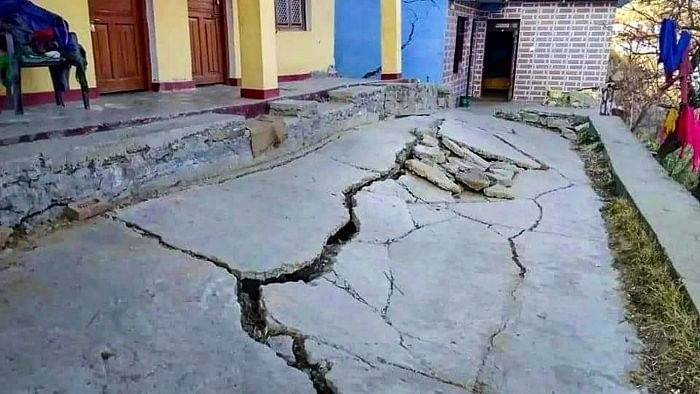
Authorities in Uttarakhand have declared Joshimath a landslide and subsidence-hit zone.
Credit: PTI Photo
The National Disaster Management Authority (NDMA) has informed in a report titled 'Post Disaster Need Assessment' that Joshimath has become a populated place and the town is 'sinking' and that it has crossed its capacity of accommodating any more constructions. "Joshimath must be declared a zone of 'no new construction'," it read, as reported by The Times of India.
The Uttarakhand High Court had earlier raised questions over the state government's decision not to make reports prepared by experts on Joshimath land subsidence public.
Earlier this year, the High Court had asked independent experts from the fields of hydrology, geology, glaciology, disaster management, geomorphology and landslides to study the land subsidence issue.
The reports were made and submitted to the NDMA. Additionally, these reports were also sent to the state government but were kept private from the public. The reports were carefully sealed and kept for the consideration of the Uttarakhand High Court.
There were some observations made by the institutions which pointed out the issues that the town is facing right now. The experts of these institutions focused on the "carrying capacity and the poor construction design and soil bearing capacity". Due to frequent landslides that happen there, the soil has become loose, which makes it prone to no new constructions.
The National Disaster Management Authority (NDMA) said in the report that, "Joshimath exceeded its carrying capacity, far beyond its capacity and the area must be declared as a no new construction zone."
The 2011 census for Joshimath recorded population of 16,709 with a density of 1,454 per square km as compared to now; that is 25,000 approximately.
The Central Building Research Institute (CBRI) also asked to review the current status of the construction practices and development.
Based on certain conditions like geo-technical and geo-climate, "good construction typology, practice, material, regulatory mechanism and awareness, according to CBRI are necessary among stakeholders".
In addition, the Geological Survey of India (GSI) reported that Joshimath has been getting a lot of ground cracks in the area where people stay and have built multistorey houses. Due to the ground cracks, many families had to forcefully leave their places; Sunil village, Manohar Bagh, Singhdhar and Marwari wards being among the densely populated areas.
The report said that, "The heavy load exerted by a dense construction of towering structures over the heterogenous colluvium debris mass, which is saturated with shallow subsurface water, only accentuated the shear stress on the slope, thus increasing subsidence in these areas."
The Union government has given in principle approval of Rs 1,465 crore for reconstructing parts of Joshimath.
The CBRI report suggested that out of 2,364 buildings in Joshimath, 20 per cent houses are "unusable", 42 per cent are under "further assessment", 37 percent are "usable" and one per cent of them "need to be demolished".
The PDNA report made by NDMA led mentioned that, "It is important that these reconstruction programmes focus on the use of green design, appropriate technologies and confined masonry."